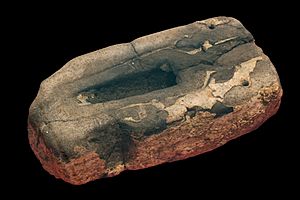Moulding facts for kids

Moulding is a cool way to shape things! It's a process where you take a liquid material and pour it into a special hollow container called a mould. Imagine a jelly mould, but for industrial stuff!
The liquid material then cools down or hardens inside the mould. When it's solid, it takes on the exact shape of the mould. This is how many everyday items are made.
You can use many different materials for moulding, like plastic, metal, glass, and even ceramic. For example, tyres for cars are made using moulds. Hot, melted rubber is poured into a tyre-shaped mould and left to set.
Moulds come in all shapes and sizes, from tiny parts to huge sections of a car. They are often made from strong, hardened steel so they can be used many times without wearing out.
How Moulding Works
Moulding is a key part of manufacturing, which is how we make products. The basic idea is always the same: a liquid or soft material is put into a mould, and then it becomes solid in the desired shape.
This process is super useful because it lets factories make many copies of the same item very quickly and accurately. Think about all the plastic toys, car parts, or even glass bottles you see – many of them started their life in a mould!
Different Ways to Mould
There are several ways to do moulding, depending on the material and what you're making. Two common types are compression moulding and injection moulding.
Compression Moulding
In compression moulding, you start with an empty mould. A piece of the raw material, often rubber or a special plastic, is placed inside. This material isn't liquid yet.
Then, the mould is pressed shut with a lot of force. High heat and pressure are used to make the material melt and flow. It fills every part of the mould's hollow space. Any extra material is squeezed out into a special groove. When the material cools, it shrinks a little bit, so mould makers have to plan for that!
Injection Moulding
Injection moulding works a bit differently but uses the same basic idea. First, the mould is closed tightly. Then, the liquid material (often melted plastic) is injected into a small hole in the mould. It's like using a giant syringe!
This method is great for making very detailed plastic products, like parts for electronic gadgets or plastic bottles. The liquid material fills the mould under pressure, making sure every tiny detail is captured before it hardens.

